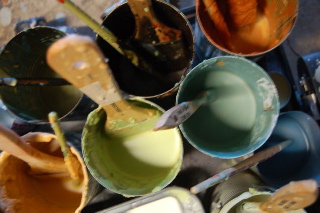 Encaustic paints are made by melting beeswax and damar (a natural resin) crystals together to make a translucent base, called encaustic medium. Color is added to the melted wax mixture in different ways--I dissolve either a bit of oil paint or dry pigment in the medium. The paint can be made more or less translucent by increasing or decreasing the amount of pigment dissolved in a given volume of wax. The wax based paint is kept on a warm surface, and the paint is used in liquid form. The melted was paint is brushed onto a rigid surface, usually a wood panel, layer upon layer. Each layer is heated just enough to fuse it to the surface of the painting. Images are made by brush painting, splashing paint, drawing with transfer papers, scratching into the surface of the painting, or floating collage materials in the wax surface.
Encaustic paints are made by melting beeswax and damar (a natural resin) crystals together to make a translucent base, called encaustic medium. Color is added to the melted wax mixture in different ways--I dissolve either a bit of oil paint or dry pigment in the medium. The paint can be made more or less translucent by increasing or decreasing the amount of pigment dissolved in a given volume of wax. The wax based paint is kept on a warm surface, and the paint is used in liquid form. The melted was paint is brushed onto a rigid surface, usually a wood panel, layer upon layer. Each layer is heated just enough to fuse it to the surface of the painting. Images are made by brush painting, splashing paint, drawing with transfer papers, scratching into the surface of the painting, or floating collage materials in the wax surface.
Encaustic paintings are interesting because of the characteristics of beeswax--because it is translucent but not clear, because it is only liquid for the two or three seconds it takes the brush to go from paint pot to painting, so that it can not be manipulated too carefully or too much. It is a challenge to make a line or a shape. The paint is going to do what it wants to do on some level. marks that are made must be heated after being laid down, which will change them from what was intended to something different.
The surface is The surface can be scraped down flat to see what is left behind, or it can remain heavily textured. There is always the option of adding more wax, and the appearance of depth is also characteristic of encaustic paintings.
Encaustic has a lot of physical, sensual beauty because the wax itself has a warmth and translucence and depth. It even smells nice.